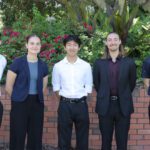An international team of astronomers have used two of the world’s largest radio telescopes to show that a mysterious source of radio bursts is in an astonishingly extreme and unusual environment. The discovery suggests that the strange source is in close proximity to a massive black hole, or within a nebula of unprecedented power.
Fast Radio Bursts (FRBs) are a recently discovered type of cosmic signal coming from deep in extragalactic space. Their physical origin remains a mystery. Using data from the Arecibo Observatory in Puerto Rico and the Green Bank Telescope in West Virginia, astronomers have shown that the radio bursts from the source FRB 121102 are almost 100 per cent polarised. The behaviour of this polarised light has allowed them to probe the source’s environment in a new way and to “peer into the lair” of the mysterious burster.
As polarised radio waves travel through a region with a magnetic field, the polarisation gets “twisted” by an effect known as Faraday rotation – the stronger the magnetic field, the greater the twisting. The amount of twisting observed in FRB 121102’s radio bursts is among the largest ever measured in a radio source, and so the researchers studying the phenomenon have concluded that the bursts are passing through an exceptionally strong magnetic field in a dense plasma.
“The only known sources in our galaxy that are twisted as much as FRB 121102 are in the Galactic Centre, which is a dynamic region near a massive black hole. Maybe FRB 121102 is in a similar environment in its host galaxy,” said Daniele Michilli, PhD candidate at the University of Amsterdam and ASTRON, the Netherlands Institute for Radio Astronomy.
“However, the twisting of the radio bursts could also be explained if the source is located in a powerful nebula or supernova remnant,” said Michilli.
Key to the discovery was detecting the bursts at higher radio frequency than ever before.
“We developed a new observing setup at the Arecibo Observatory to do this, and our colleagues from the Breakthrough Listen project at the Green Bank Telescope confirmed the results with observations at even higher radio frequencies,” said Andrew Seymour, Staff Astronomer at Arecibo.
Australian researcher Dr Charlotte Sobey from the Curtin University node of the International Centre for Radio Astronomy Research and CSIRO said, “Detecting the bursts at higher radio frequencies than ever before has enabled us to measure the immense amount of twisting imparted on the source’s considerably polarised light by the extreme environment within its galaxy.”
A year ago, the research team pinpointed the location of FRB 121102 and reported that it lies in a star-forming region of a dwarf galaxy at a distance of over 3 billion light years from Earth. At this great distance, an enormous amount of energy is needed to power each burst – roughly as much energy in a single millisecond as the Sun releases in an entire day.
FRB 121102 is the only known repeating FRB, and this has also raised the question of whether it has a different origin compared to apparently non-repeating FRBs.
“Fast Radio Bursts are usually a one-off flash in the pan, but this one is repeating so it gives us a unique opportunity to understand this type of phenomenon, especially as the amount of twisting seems to vary by at least 10 per cent over several months,” said Sobey.
“We are continuing to monitor how the properties of the bursts change with time”, said Jason Hessels, from the University of Amsterdam & ASTRON. “With these observations we hope to distinguish between the two competing hypotheses of a neutron star either near a black hole or embedded in a powerful nebula.”
With a number of wide-field radio telescopes now coming online, more sources similar to FRB121102 are expected to be discovered in the coming year, with astronomers poised to answer more fundamental questions about their nature and origin.
The team presented their findings at the American Astronomical Society’s winter meeting (#AAS231) in Washington, DC. The results appear on the cover of the January 11th edition of Nature.
***This media release was issued by ICRAR***



